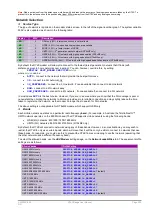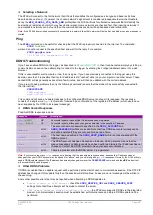
UM-0085-B09
DT80 Range User Manual
Page 206
RG
TCP/IP Parameters
In order to operate correctly on a TCP/IP network, the
DT80
must know the following:
•
its own unique
IP address
•
for Ethernet connections, the
subnet mask
applicable to the network to which it is connected
•
(optional) the
gateway IP address
applicable to the network to which it is connected
•
(optional) the
DNS server
address applicable to the network to which it is connected
IP Address
Every device that is connected to a TCP/IP network must have its own unique identifier, called its
IP address
, and the
DT80
is no exception. No two devices in the same network can have the same IP address.
An IP address is single 32-bit integer, but it is normally written as four numbers (each in the range 0-255), separated by
periods, e.g.
192.168.2.101
.
IP addresses are actually associated with network interfaces, rather than devices. The
DT80
has multiple network
interfaces, and may therefore have multiple IP addresses – one for its Ethernet interface, one for the integrated modem,
and one for any serial port set up to use PPP.
Public and Private Addresses
Traditionally, all IP addresses were "public", which meant that if you knew a particular computer's IP address then you
could connect to it from any computer on any IP network anywhere in the world. This did, however, present some
problems. Firstly, it meant that every computer needed a globally unique IP address, and with the explosive growth of the
Internet, IP addresses are simply running out. Secondly, computers with externally visible IP addresses are potentially
vulnerable to malicious programs on the Internet which attempt to exploit application or operating system "loopholes" in
order to gain control of a computer for nefarious purposes.
Nowadays, the usual practice is to set up private networks, where all computers on the network have a private IP
address. In order for these computers to access web servers and such like on the Internet, all external traffic is passed
via a
NAT router
, so called because it performs
Network Address Translation
, i.e. it converts private IP addresses into
"real" IP addresses and vice versa. The end result is that the computers on the private network can "see out", but
external systems cannot "see in" – the router effectively acts as a "firewall" between the secure private network and the
Internet.
This is fine for "client" computers such as the one you use for accessing the web or email. For "server" devices (e.g. the
DT80
, which has internal web and FTP servers), NAT can present a problem if you want to be able to access the
DT80
's
servers via the Internet. This will be discussed further in
Accessing the DT80 via the Internet (P238)
.
Private IP addresses
normally begin with 10.x.x.x, or 192.168.x.x, or 172.16.x.x through 172.31.x.x, or 169.254.x.x.
These addresses only need to be unique within the local network. Addresses outside these ranges can normally be
assumed to be
public IP addresses
. Public IP addresses need to be assigned by an Internet Service Provider (ISP).
Assigning an IP Address (Ethernet)
There are two methods of assigning an IP address to the
DT80
's Ethernet port:
•
it can be manually specified in the
DT80
's profile. This is termed a
static IP address
•
the
DT80
can automatically obtain a
dynamic IP address
from a
DHCP server
on the local network. Most
networks include a Dynamic Host Configuration Protocol (DHCP) server, which is responsible for providing IP
addresses to computers connected to the network. If a DHCP server is not available then the
DT80
can assign
itself an
Auto-IP
address
Note:
a DHCP server will typically also automatically set the
DT80
's subnet mask, gateway and DNS server parameters, which are
described further below.
Assigning an IP Address (PPP)
If the
DT80
's network connection is made via a point-to-point link to another computer, as opposed to a shared Ethernet
network, then IP addresses are assigned a little differently.
For a
DtUsb
connection to the
DT80
's USB port, the
DtUsb
software will automatically assign IP addresses to itself and
the
DT80
. These are private addresses, visible only to
DtUsb
and the
DT80
.
For a serial PPP connection to the
DT80
's USB, host RS232 or serial sensor port, the
DT80
will normally assign an IP
address to itself (1.0.0.
n
) and to the other computer (1.0.1.
n
), where
n
is 1 for the serial sensor port, 2 for the host RS232
port or 3 for the USB port.
For a connection using the integrated modem, the
DT80
will be assigned an IP address by the mobile carrier's server
once the modem has registered on the mobile network. Depending on the carrier, this IP address may be a public
address or a private address. If your carrier provides a private address then the
DT80
's servers will not be able to be
accessed via the Internet).
















































